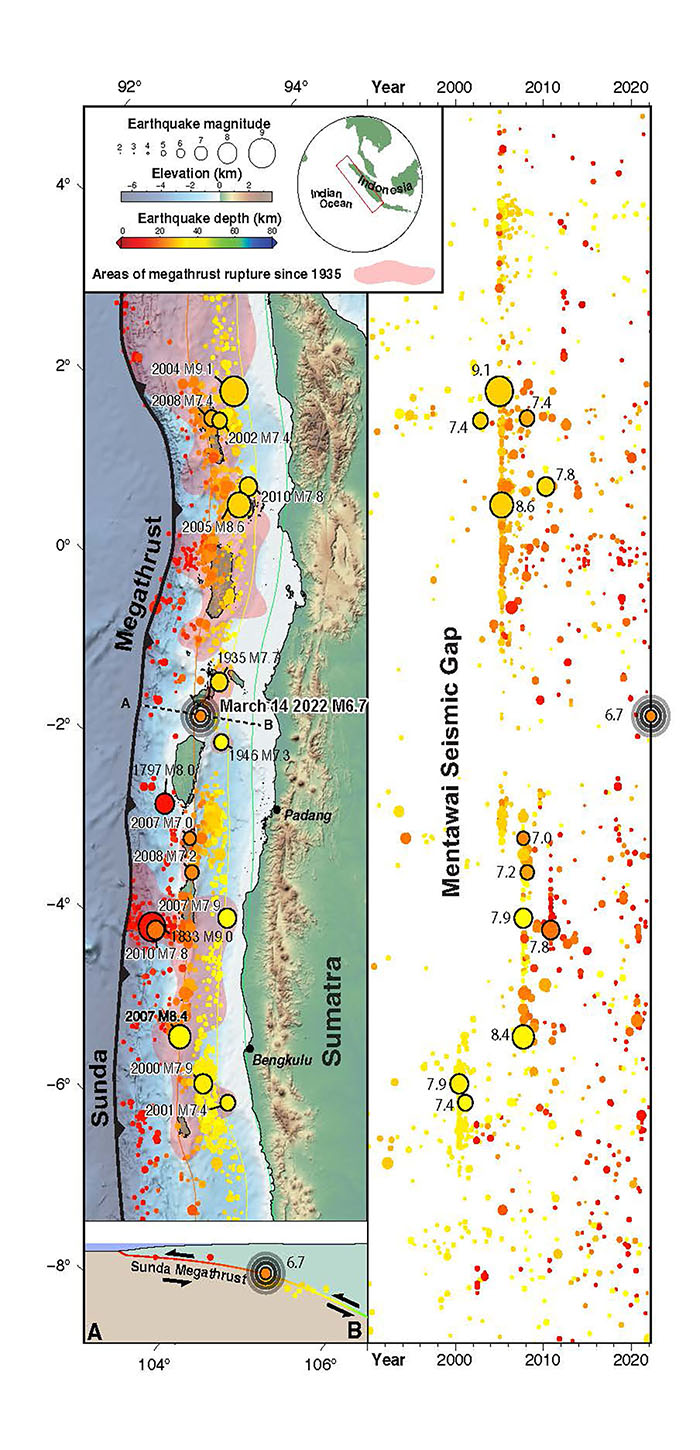A strong magnitude-6.7 earthquake struck off the west coast of Sumatra, Indonesia, on 14 March 2022 at approximately 5:10am (Singapore time). While it is unlikely that this earthquake caused major damage owing to its remote location, it is a reminder of the constant earthquake and tsunami hazards off the west coast of Sumatra.
The event occurred along a plate boundary fault called the Sunda Megathrust, where the Indo-Australian plate subducts below the Sunda plate at a rate of about 5.5 centimetres per year.
Although many faults produce large earthquakes every few hundred or even thousand years, the Sunda Megathrust, located offshore Sumatra, tends to rupture more frequently. To the north, this fault generated great earthquakes of magnitude-9.2 in 2004 and magnitude-8.6 in 2005. To the south, seven earthquakes of at least magnitude-7.0 have occurred since 2000.

Block diagram showing the tectonic setting of the 14 March 2022 MW 6.7 earthquake and some EOS monitoring stations (Source: Earth Observatory of Singapore)
The Sunda Megathrust hosts many earthquakes, both small and large, but some parts of the fault have been more active than others during recent decades. In some areas, no great earthquakes – magnitude-8 or larger – have been recorded in over 180 years. In these areas, called seismic gaps, the two sides of the fault have accumulated stress for many decades as the plates have been pushed together steadily without any large earthquakes to release this stress.
The 14 March earthquake occurred at the edge of one of these seismic gaps. To the north of this earthquake, the subduction zone experiences moderate-to-large earthquakes such as the magnitude-7.7 event in 1935. To the south, the subduction zone experiences great earthquakes such as the magnitude-~8.7 event in 1797 but it has not produced a big earthquake in nearly 225 years. "Because of the long time since the last large rupture, the part of the subduction zone just south of the 14 March earthquake is known as the Mentawai Seismic Gap," said Assistant Professor Aron Meltzner, a Principal Investigator at the Earth Observatory of Singapore (EOS), who studies active faults and past earthquakes.
The Mentawai Seismic Gap is a 300-kilometre-long region from just south of Tanahbala Island to North Pagai Island. "This week’s event is one of the largest events that we have recorded in this region," said Asst. Prof Judith Hubbard, a Principal Investigator at EOS, who studies active fault systems in Southeast Asia.
"Because it is a seismic gap, this part of the fault is thought to be likely to produce a large earthquake and tsunami in the next few decades," said Asst. Prof Meltzner. Research by EOS scientists and collaborators has shown that rupture of this fault could generate an earthquake approaching magnitude-9, nearly as large as the 2004 great Sumatra-Andaman earthquake.

(Left) A map of the Sunda Megathrust offshore of Sumatra, showing the location of the 14 March 2022 MW 6.7 earthquake. (Right) Seismicity projected horizontally from the map, plotted over time. The Mentawai Gap is notable as a region without either a large earthquake slip patch (pink zones on the map) or significant seismicity. The 14 March 2022 earthquake occurred at the northern edge of this gap (Source: Kyle Bradley/Earth Observatory of Singapore)
EOS scientists and their regional collaborators have studied the Sunda Megathrust and the Mentawai Seismic Gap using many different techniques over several decades. They have mapped the seafloor, installed Global Positioning Systems (GPS) stations to monitor plate motion, and interpreted the record of past earthquakes preserved in corals.
As earthquakes on the subduction zone push the islands off the west coast of Sumatra up and down, corals in coastal regions rise or fall and preserve a record of these vertical land movements in their skeletons. These corals can be used to identify the locations, timing, and magnitudes of seismic events since the early 1700s. For example, they show that different islands were pushed up due to earthquakes in 1797, 1833, and 1935. In turn, this helped identify the boundaries of seismic gaps. "It is from corals that we know the 14 March earthquake occurred at the edge of a region where we are expecting a large earthquake in the future," said Asst. Prof Meltzner.

An infographic showing how corals can record earthquakes, providing valuable information about earthquakes and past sea-level changes (Source: Earth Observatory of Singapore)
"We cannot predict when the next great megathrust earthquake will occur within the Mentawai Seismic Gap," said Dr Kyle Bradley, an EOS Principal Investigator who studies fault systems in the region. "This week’s magnitude-6.7 earthquake is an opportunity for individuals and communities in the surrounding regions to review their preparations for an earthquake of magnitude greater than 8.5, like we have seen in other areas of Sumatra over the past several decades but which has yet to occur in the Mentawai Seismic Gap. Such an earthquake could trigger a destructive tsunami that would impact the islands and the mainland coast of Sumatra," he added.